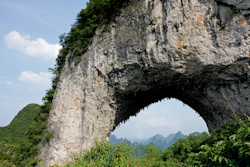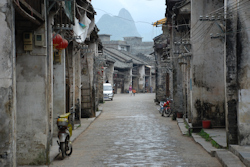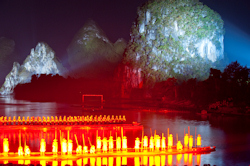A voyage through Guilin’s Yangshuo County
Guilin - located in the Guangxi Zhuang Autonomous Region in the southeast of China - is renowned for its unique karst landscapes and bounteous opportunity for outdoor pursuits. Biju Sukumaran explores Guilin’s awe-inspiring Yangshuo County by cycle, raft and on foot in an unforgettable journey.
I'm cycling with my friends along the roads outside of Yangshuo. The wind lashes through the countryside, across the fields of osmanthus blossoms that are iconic to Guilin. Tour buses and cars weave along the wide roads, and they, combined with the wind and the gloriously pristine scenery, seem to propel us to race furiously against one another on our rented bikes. We whizz past roadside restaurants selling everything from duck to dog, past villagers carefully putting out row upon row of persimmon fruits to dry in the midday sun. I feel like I am finally beginning to see the China depicted in the innumerable television shows and documentaries of my childhood.
UNIQUE LIMESTONE HILLS
 Moon Hill
Moon HilliStockphoto / Thinkstock
Located in Guangxi Province in southern China, close to the border with Vietnam, Yangshuo is renowned for its pristine, karst-studded landscape. A popular getaway for Chinese tourists, the area is one of the best places to enjoy the great outdoors in China. Its unique limestone hills are the reason why the province is one of China's premier areas for climbing. Several companies such as Terratribes Expeditions and Karst Climber provide transportation and information on everything from where to purchase equipment to the route you should attempt.
There are hundreds of routes for all abilities. The geological formations sometimes take on unusual shapes, like Moon Hill, a bridge-like karst with a circular gap, which offers spectacular views and difficult overhangs, while others, like the White Mountain, contain more challenging terrain for veteran climbers.
I’m not here for the climbing but for more sedate activities. We enter Yangshuo and head for The Lazy Men's hostel, its walls crowded with pictures of guests and trip itineraries. My Chinese friend immediately strikes up a conversation with the owner, who advises us to rent bicycles from a shop just a few metres down the road. Virtually every street corner has an outdoor bike shop with rentals available by the hour or by the day. We arrange a rafting trip for the following day.
RAFTING THE LI RIVER
The next morning, we cycle for about an hour to a small village beside the Li River where we meet our rafting guides. Our bicycles are efficiently loaded into a truck and whisked away. We are provided with two small bamboo rafts that seat two people, and we spend the better part of the day leisurely floating down the river propelled by our guides, stopping to navigate the locks en route. Our guides chat amiably to each other, sometimes telling jokes, sometimes racing each other, never tiring in their endeavours.
I ask to try to navigate the rafts, using the long bamboo stick to push off from the shallow riverbed, but it’s more difficult than it seems and my guide soon laughingly resumes poling as we careen off course. The water is clear and cool, as is the air; we're surrounded by karsts and greenery and, away from the crowds of modern China, an overwhelming sense of peace and freedom prevails.
 Xingping
XingpingHemera / Thinkstock
Among the rice paddies, our guides point out some of the many unusual formations in the karsts and hills around us. These include The Mountain of Splendid Hues with its many-coloured rocks, and the Elephant Trunk Hill, with a half-moon opening worn by the river to make a shape reminiscent of a trunk. Along the way we see the Yellow Cloth Shoal, its shallow riverbed like a yellow sheet, and we stop to explore Xingping Town, an old yet picturesque village built with sturdy grey stones, a remnant of its original function as a fortification over 500 years ago.
Continuing on, we ignore the option of grabbing a bite to eat on one of the floating restaurants but pause to take pictures of the stunning backdrops, one made especially famous by appearing on the back of the 20 yuan note. Here, sequences of karsts march into the distance, reflected clearly on the placid river in the foreground, winding past, then through the hills on into the distance.
Back in the town, we explore by taking a quiet river walk with small bars, clubs, and restaurants. Street markets selling handmade crafts abound as the day fades, the streets becomes alive with revellers. Club music thumps out of speakers as we pass crowded pubs, but hungry, we ignore them and cross small bridges to access further parts of the river walk. We pass an Indian restaurant, then an Italian pizzeria, but the lederhosen uniforms of the German beer garden attract us the most.
LUMINOUS CAVES
 Silver Cave
Silver CaveCreative Commons / SarahDepper
The next morning we awake early, and cross to one of the many places selling the local specialty - Yangshuo rice noodles. The noodles are cheap, fast, and served with pickled condiments, their warmth a welcome relief from a long day of outdoor activity, or in our case, a night of revelry.
We've booked a tour to visit one of the many caves on the outskirts of town. The caves are all filled with unique geological formations, stalagmites and stalactites that form eerie shapes, highlighted by the glow of multicoloured floodlights. The tour guides and pamphlets ascribe colourful names to each and every shape.
"Can you see the three dragons in this pillar?" one says.
None of us can, but the displays do not fail to impress. Each cave has a speciality – some contain rivers and have portions that must be explored via boat, while others use elevators and trams. We spend several hours walking through Silver Cave, featuring high ceilings, some several stories tall, and shining walls. Formations like the Screen of Music, the Buddha Discussing the Buddhist Sutras, and the Solitary Pillar Propping up the Sky, are all accentuated by shadows and light. Lost in a warren of fluted rock and climbing paths, we finally emerge from the cave, blinking blearily in the sun, to the tune of street merchants selling trinkets.
THEATRE OF DREAMS
 Spectacular show
Spectacular showHemera / Thinkstock
Later that evening, after a meal of Yangshuo beer fish (a slightly sweet preparation of fish braised in beer with vegetables, peppers, and garlic) we're off to the theatre to see Impression Liu Sanjia, showcasing the songs and costumes of the many ethnic minority groups indigenous to the area.
The awe-inspiring natural setting forms a backdrop to the drama; the stage is composed of the Li River and its banks in the foreground, while in the background, gigantic coloured lights illuminate several karsts. A grand performance is expected; Yimou Zhuang, director of the spectacular opening ceremony of the 2008 Beijing Olympics, choreographed it.
The singing begins as hundreds of male performers dressed in traditional regalia sing an old love song to their female counterparts on the opposite bank.
Listening intently whilst shivering slightly in the crisp, cool air and with my stomach filled with local cuisine, I am, for the moment, completely sated.
Do you have any Feedback about this page?
© 2025 Columbus Travel Media Ltd. All rights reserved. No part of this site may be reproduced without our written permission, click here for information on Columbus Content Solutions.









 You know where
You know where